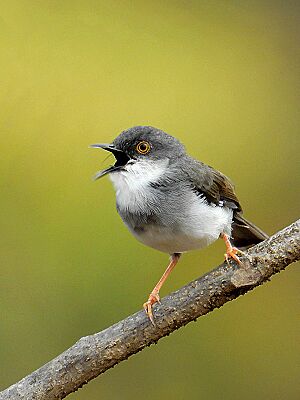Grey-breasted prinia facts for kids
Quick facts for kids Grey-breasted prinia or Franklin's prinia |
|
|---|---|
 |
|
| P. h. albogularis from Mangaon, Raigad, Maharashtra |
|
| Conservation status | |
| Scientific classification | |
| Genus: |
Prinia
|
| Species: |
hodgsonii
|
| Synonyms | |
|
|
The grey-breasted prinia or Franklin's prinia (Prinia hodgsonii) is a small bird that looks a bit like a wren. It belongs to a group of birds called passerines. These birds are mostly found in warmer parts of the world, especially in Asia.
This prinia lives in the Indian subcontinent, Sri Lanka, and parts of southeast Asia. Like other prinias, it often holds its tail pointing upwards. You can easily spot it by the smoky grey band across its chest. This band stands out against its white throat. Its beak is black, and its legs are pink. The tail feathers are grey with white tips.
Contents
About the Grey-breasted Prinia
Naming the Prinia
This bird was first named by James Franklin in 1831. He called it Prinia gracilis. Later, Edward Blyth gave it the name Prinia hodgsonii in 1844. This was because its first name was already used for another bird, the graceful prinia.
Scientists have found different types of Grey-breasted Prinias. These types are called subspecies. They look a bit different depending on where they live:
- P. h. hodgsonii: This type lives in India and Bangladesh. It loses its chest band in winter.
- P. h. rufula: Found in the Himalayan foothills. It moves to lower areas in winter. This type has a reddish-brown color on its sides and upper body.
- P. h. albogularis: Lives in the Western Ghats of India. It has the widest and darkest chest band.
- P. h. pectoralis: Found in eastern and southeastern Sri Lanka. This type keeps its grey chest band all year. Females have a band that is not complete in the middle.
- P. h. erro: Lives from eastern Myanmar to Thailand and southern Indochina.
- P. h. confusa: Found from southern China to northeast Laos and northern Vietnam.
What Does it Look Like?

These birds are about 11 to 13 centimeters (4 to 5 inches) long. They have a long, grey tail with feathers that get shorter towards the end. The tips of these feathers are white. They have strong pinkish legs and a short, black beak. Their eyes have an orange ring around them.
Most male and female prinias look the same. But in Sri Lanka, the female P. h. pectoralis has a chest band that is not complete. The underside of the bird is a creamy white color. The grey chest band stands out against the white throat during the breeding season. They have a reddish-brown patch on their wings. Their upper body is smoky grey during the breeding season. In other times of the year, it turns olive brown.
Non-breeding birds might have a short, faint white stripe above their eye. They often do not have the chest band. Young birds look like non-breeding adults but are more reddish-brown on top. The special type in Sri Lanka, P. h. pectoralis, keeps its summer colors all year. Young birds have a pale lower part of their beak. Their tail feathers are shorter in summer than in winter.
Where Does it Live?
This bird likes to hide in open woodlands, bushy areas, and hedges near farms. You can also find it in bamboo forests, mangrove swamps, and reeds. The P. h. rufula type has been seen in sugarcane fields near Kathmandu valley.
It is very common in India. It moves a little bit south during winter. You can find it from the Himalayan foothills to Southern India. It also lives in eastern Indian states like Arunachal Pradesh and Assam. The bird's home also stretches to Pakistan, Burma, Vietnam, Sri Lanka, and southern China. It lives from flat plains up to 1000 meters (3,280 feet) high. The P. h. rufula type can live up to 1800 meters (5,900 feet) high in Meghalaya.
Behavior and Life Cycle

What Do They Eat?
Like most warblers, Grey-breasted Prinias eat insects. They mainly feed on ants, small beetles, and caterpillars. They find these insects among the branches and leaves of small trees. They also drink nectar from flowers of trees like Erythrina. In summer, their forehead might get covered with pollen. This can make their head look orange or yellow.
How Do They Behave?
These birds are usually seen in pairs or small groups. Sometimes, they form larger groups of five or more birds. They can even gather in groups of up to twenty. As they move between branches, they often jerk their tail.
Reproduction
The breeding season starts when the rains begin. The male bird sings from a high spot. He also flies up and down in the air while singing. His song is a squeaky sound that goes chiwee-chiwee-chiwi-chip-chip-chip.
The nest is shaped like a cup and is made of grass. It is placed between leaves that the birds sew together with spiderwebs. It looks a bit like the nest of a common tailorbird. However, the prinia's nest is usually closer to the ground. A female typically lays three or four eggs. The eggs can be glossy blue, pinkish-white, greenish-blue, or even pure white. They usually have reddish-brown spots at the wider end. Both parents take turns sitting on the eggs. The eggs hatch after about ten to eleven days. These birds can raise more than one group of young birds in a single season.
Their Calls
During the breeding season, the male bird sings excitedly from an open branch. His squeaky song sounds like yousee-yousee-yousee-which-which-which. When the birds are moving around, they also make a soft call that sounds like zee zee zee.


